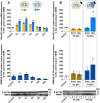Cold stress protein RBM3 responds to hypothermia and is associated with good stroke outcome
- PMID: 33585816
- PMCID: PMC7869850
- DOI: 10.1093/braincomms/fcaa078
Cold stress protein RBM3 responds to hypothermia and is associated with good stroke outcome
Abstract
RNA-binding motif protein 3 is a molecular marker of hypothermia that has proved neuroprotective in neurodegenerative disease models. However, its relationship to the well-recognized therapeutic effect of hypothermia in ischaemic stroke had not been studied. In this work, the expression of RNA-binding motif protein 3 was investigated in ischaemic animal models subjected to systemic and focal brain hypothermia, specifically the effects of RNA-binding motif protein 3 silencing and overexpression on ischaemic lesions. Moreover, the association of RNA-binding motif protein 3 levels with body temperature and clinical outcome was evaluated in two independent cohorts of acute ischaemic stroke patients (n = 215); these levels were also determined in a third cohort of 31 patients derived from the phase III EuroHYP-1 trial of therapeutic cooling in ischaemic stroke. The preclinical data confirmed the increase of brain RNA-binding motif protein 3 levels in ischaemic animals subjected to systemic and focal hypothermia; this increase was selectively higher in the cooled hemisphere of animals undergoing focal brain hypothermia, thus confirming the direct effect of hypothermia on RNA-binding motif protein 3 expression, while RNA-binding motif protein 3 up-regulation in ischaemic brain regions led to functional recovery. Clinically, patients with body temperature <37.5°C in the first two cohorts had higher RNA-binding motif protein 3 values at 24 h and good outcome at 3 months post-ischaemic stroke, while RNA-binding motif protein 3 levels in the cooled third cohort tended to exceed those in placebo-treated patients. These results make RNA-binding motif protein 3 a molecular marker associated with the effect of hypothermia in ischaemic stroke and suggest its potential application as a promising protective target.
Keywords: RBM3; hypothermia; neuroprotection; stroke; translational study.
© The Author(s) (2020). Published by Oxford University Press on behalf of the Guarantors of Brain.
Figures







References
-
- Castillo J, Dávalos A, Marrugat J, Noya M.. Timing for fever-related brain damage in acute ischemic stroke. Stroke 1998; 29: 2455–60. - PubMed
-
- Danno S, Nishiyama H, Higashitsuji H, Yokoi H, Xue J-H, Itoh K, et al.Increased transcript level of RBM3, a member of the glycine-rich RNA-binding protein family, in human cells in response to cold stress. Biochem Biophys Res Commun 1997; 236: 804–7. - PubMed
LinkOut - more resources
Full Text Sources
Other Literature Sources
